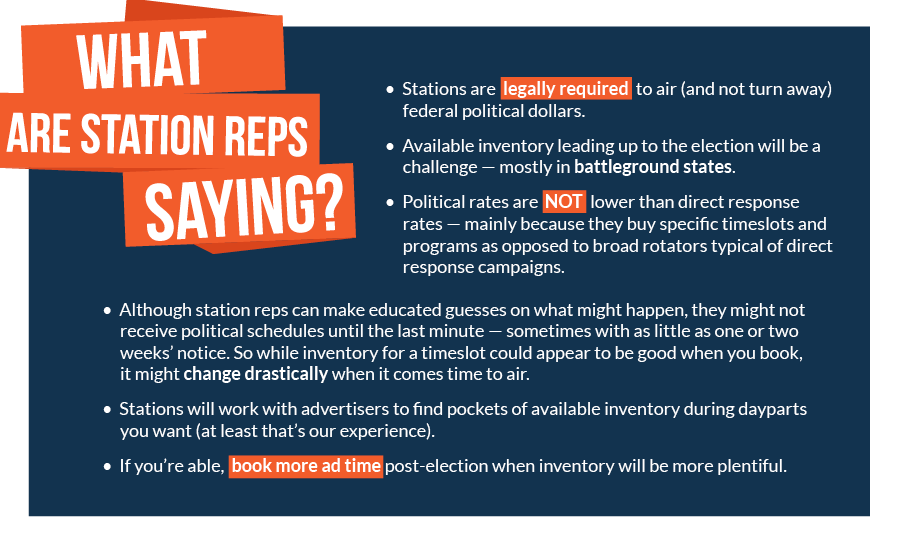Managing DRTV Clearance in a Presidential Election Year: Your Questions Answered.
Len Zappolo DRTV, Health Care Marketing, Insurance Direct Marketing, Medicare MarketingIs It Possible for DRTV Advertisers to Combat the Glut of Political Ads Leading up to the November 8th Election?
‘Tis the season for political advertising on TV. For the next several weeks, the flow of political ads will increase, making it harder for other advertisers’ ads to air.
Remember, there’s a finite amount of ad time per hour on TV. This creates a particular challenge for all advertisers, but especially for health insurers who are operating within the designated annual enrollment period (AEP) to generate all of their 2016 sales for Medicare Plans. For 2017 Medicare coverage, open enrollment runs from October 15 to December 7. Election Day is November 8th, which means that nearly half of AEP will overlap with election advertising this year (with advertising actually overlapping for a longer period).
Since I wrote my previous blog post regarding DRTV ad clearance, curious clients have asked questions regarding their campaigns. Here are some of the key concerns and our responses.
How difficult will it be to get my ads to air in my target markets?
One of the first things to consider is the region in which you’re advertising. Some states are not anticipating as much activity as others.
The 11 battleground states are where political spending is expected to be high – and your challenges will be greatest – are New Hampshire, Pennsylvania, Ohio, Virginia, North Carolina, Florida, Michigan, Wisconsin, Iowa, Colorado, and Nevada.
Keep in mind that factors such as network, length of spot, and time of day can impact your clearance rates. For example, if you’re running ads to a targeted audience on HGTV during midday, you’ll likely be okay. But if you book your ads for prime time on the major networks or CNN, your ad could be shut out.
Does each advertiser pay the same rate per ad?
It’s difficult to answer for the simple reason that campaigns are rarely identical. They differ by length, stations and networks, daypart specification, and frequency among other variables. This is not really something worth getting hung up about.
How can we combat tight inventory during political seasons?
The following list covers most options, some of which are worst-case scenarios. All tactics could be used, or some in varying combinations. It simply depends on the situation as to which tactics to use and when.
- Book orders sooner. Booking orders a month or more in advance may provide some leverage.
- Buy around political advertisers’ dayparts/programs. Work with stations to find pockets of time where inventory is more plentiful (i.e., non news-oriented time periods).
- Increase rates. If the spots aren’t clearing, you may have to pay higher rates to clear.
- Be flexible on budget. May need to increase budget to overcome increase in rates per station from prior year.
- Consider increasing spot frequency. You may need to place more, to clear more. (Remember, even in the quietest of advertising times, you rarely clear 100% of your DRTV campaign booking.)
- Be flexible on daypart and telemarketing scheduling. Consider adding dayparts outside of the norm as well as broadening hours of operations (e.g., including weekends).
- Keep options open regarding phone numbers. Having more numbers available enables us to quickly add stations to make up for low clearance on other stations. This could be for sub/secondary channels, local cable, or video on stations’ main websites.
- Communicate with your agency to allocate unused dollars. You may have an opportunity to be move funds into other direct response channels to better help achieve your broader program goals.
What about other direct response channels?
Do direct mail and digital, for example, face the same challenges as DRTV during a presidential election cycle? Yes, they do. Here’s a quick rundown of key points by medium:
Direct Mail
- Plan ahead and book vendors in advance, so that they know what your needs are and can prepare or help you schedule.
- Plan mail dates to avoid mail hitting homes the few days before the election. It might be worth delaying your drop date until after November 8th.
Digital
- The more targeted you are, the less of a concern it is.
- Broad-based campaign displays have the greatest risk of overlap with political ads.
- If you’re buying on cnn.com, for example, expect to have overlap and placement issues.
- If you have to conduct broad-based awareness campaigns during the election, make them as targeted as possible to avoid being shut out.
- Search is unique and should be fine.
PPC, SEM, and email are highly targeted whereas banner ads and display ads are more limited during a campaign cycle.
- Facebook PPC could have some overlap if you’re not focused in how you’re targeting.
The important thing to realize when advertising at the height of a presidential election campaign cycle is that yes, there are concerns – particularly if October-November is key to making your annual numbers – as it is with Medicare during AEP. However, none are insurmountable and all can be managed with careful planning and a watchful eye. It is for this reason, whether in situations such as this or “normal” cycles, we never take a set-it-and-forget-it approach when we book campaigns for our clients.
Have concerns about your DRTV clearance rates or the effectiveness of your other campaigns? Let us know and we’ll be more than happy to help!